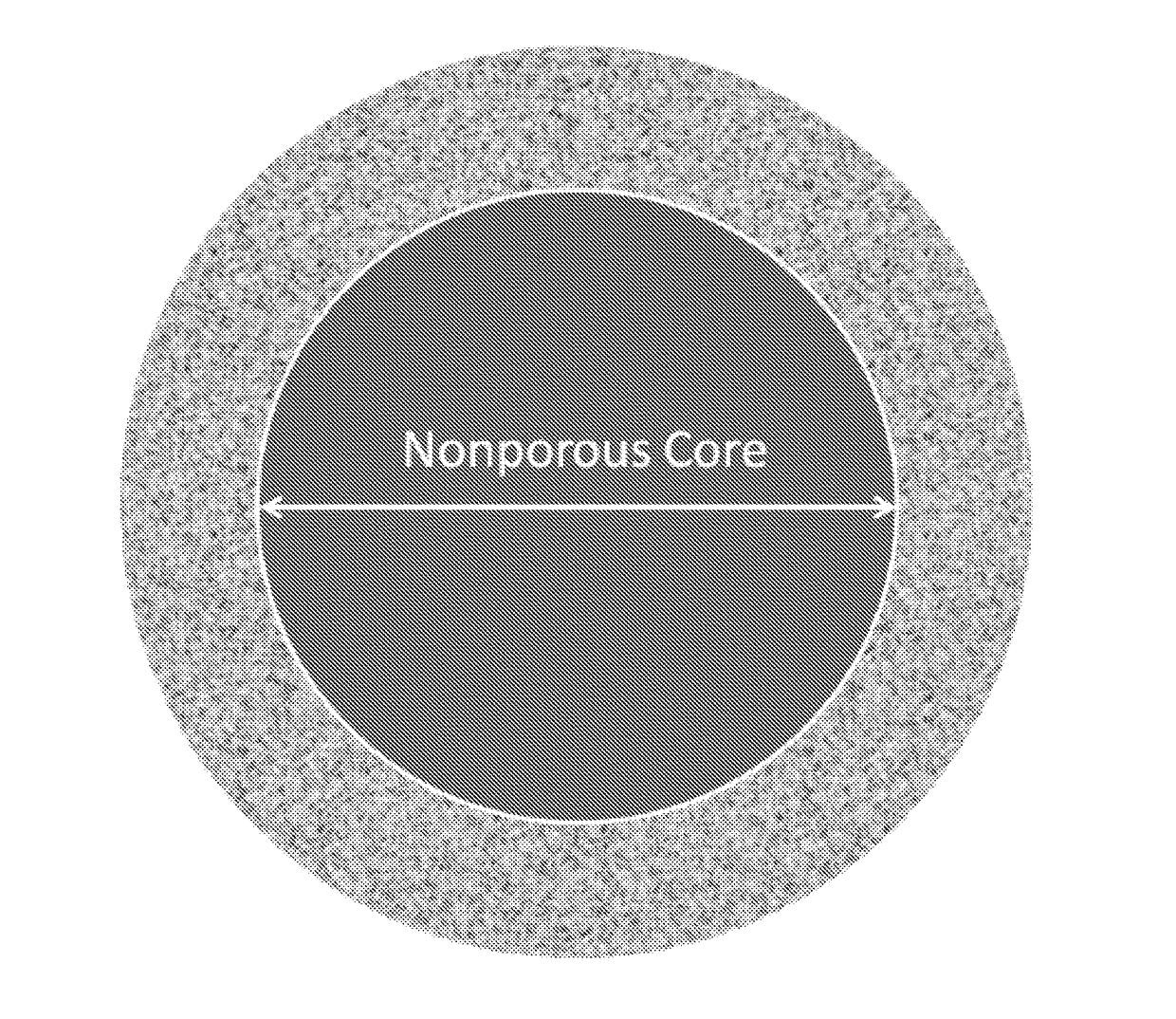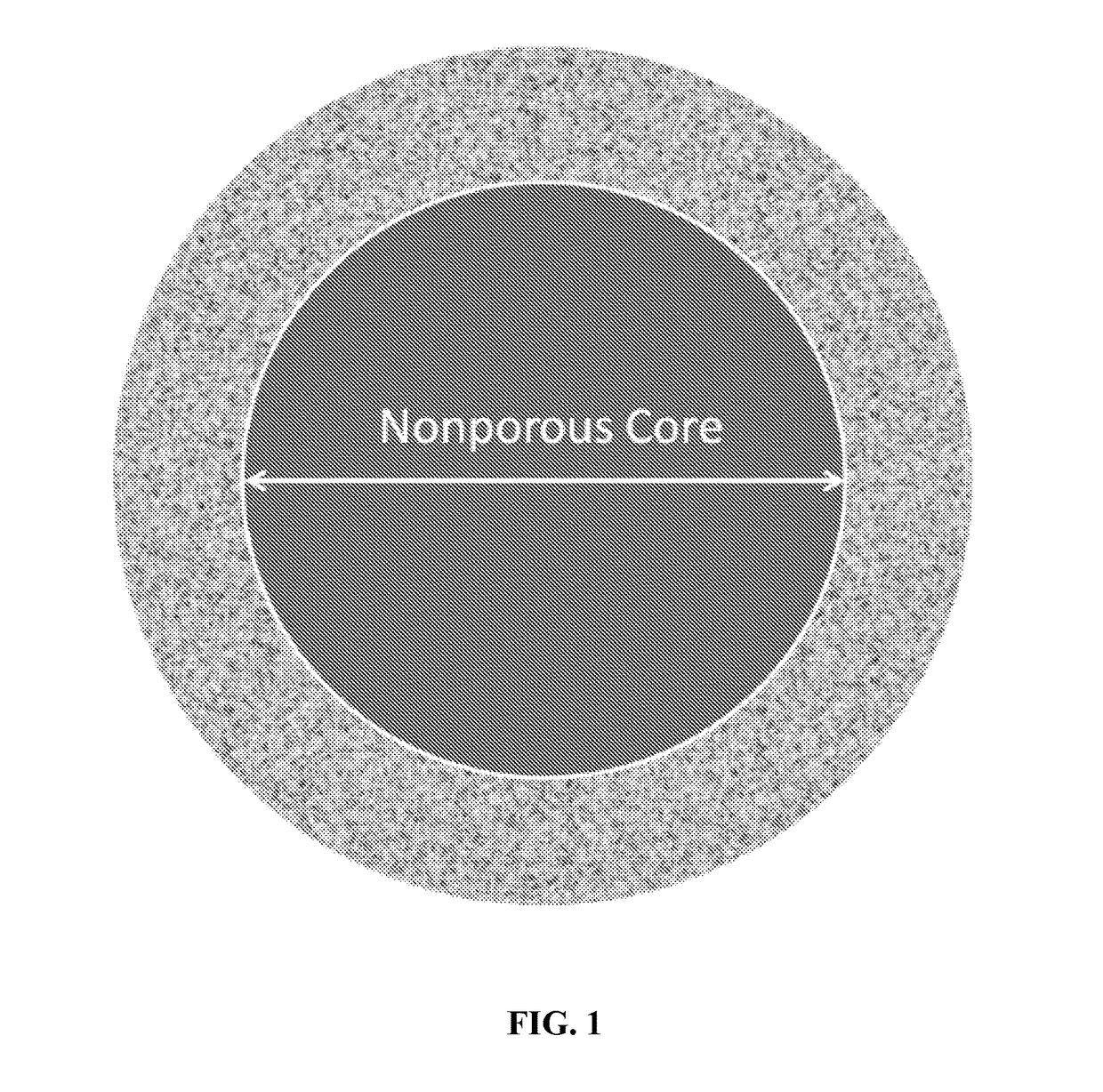New ultrahigh efficiency, superficially porous particle (SPP) chiral phases for liquid chromatography
a chiral phase and liquid chromatography technology, applied in separation processes, other chemical processes, silicon compounds, etc., can solve the problems of ineffective large-scale polymeric chiral selectors (type 3 above) and adsorbed chiral selectors, and show few, if any, enhanced separation properties, and achieve enhanced chiral separation.
- Summary
- Abstract
- Description
- Claims
- Application Information
AI Technical Summary
Benefits of technology
Problems solved by technology
Method used
Image
Examples
example 1
on of Cyclofructan Based SPP CSPs
[0048]Cyclofructans are cyclic oligosaccharides that possess 18-24 hydroxyl groups. These hydroxyl groups can be used as reactive functionalities to covalently bond the cyclofructan (or cyclofructan derivative) to SPP silica. Cyclofructans can be used as chiral selectors in their native form or in a derivatized format. Derivatization of the cyclofructan molecules can take place before or after they are immobilized on the SPP silica. The derivatizing groups are either alkane (e.g. linear alkane C1-C30, branched alkane C1-C30, unsaturated alkane C1-C30, cyclic alkane C1-C30, linear and / or cyclic alkane containing heteroatoms (e.g. N, S, O) C1-C30) or aromatic (benzyl, derivatized benzyl (e.g. NO2, Cl, F, Br, CH3 functionalized), phenyl, derivatized phenyl (e.g. NO2, Cl, F, Br, CH3 functionalized), naphthyl, derivatized naphthyl (e.g. NO2, Cl, F, Br, CH3 functionalized), or biaryl) in nature and are bonded to the cyclofructan by a number of chemical lin...
example 2
on of Cyclodextrin Based SPP CSPs
[0052]Cyclodextrins are cyclic oligosaccharides that possess 18-24 hydroxyl groups. These hydroxyl groups can be used as reactive functionalities to covalently bond the cyclodextrin (or cyclodextrin derivative) to SPP silica. Cyclodextrins can be used as chiral selectors in their native form or in a derivatized format. Derivatization of the cyclodextrin molecules can take place before or after they are immobilized on the SPP silica. The derivatizing groups are either alkane (e.g. linear alkane C1-C30, branched alkane C1-C30, unsaturated alkane C1-C30, cyclic alkane C1-C30, linear and / or cyclic alkane containing heteroatoms (e.g. N, S, O) C1-C30) or aromatic (benzyl, derivatized benzyl (e.g. NO2, Cl, F, Br, CH3 functionalized), phenyl, derivatized phenyl (e.g. NO2, Cl, F, Br, CH3 functionalized), naphthyl, derivatized naphthyl (e.g. NO2, Cl, F, Br, CH3 functionalized), or biaryl) in nature and are bonded to the cyclodextrin by a number of chemical lin...
example 3
on of Glycopeptide Based SPP CSPs
[0056]Macrocyclic glycopeptides (e.g. teicoplanin, boromycin, ristocetin A, dalbavancin, and vancomycin) possess amine and hydroxyl functionalities which can be used as reactive groups to covalently bond the glycopeptide (or glycopeptide analog; e.g. teicoplanin aglycone) to SPP silica. There are a number of bonding chemistries that can be used to chemically immobilize macrocyclic glycopeptides on SPP silica (e.g. ether, carbamate, thioether, thiocarbamate, ester, triazole, and urea). The following lists example bonding strategies, using teicoplanin as the model chiral selector.
[0057]First, in a 250 mL round-bottom flask teicoplanin (3 mmol) was dissolved in anhydrous DMF (60 mL) under and argon blanket and TEA (3 mL) was added. Then, 3-triethoxysilylpropyl isocyanate (4 mmol) was added and the reaction vessel was heated to 90° C. for 5 hours. Meanwhile, the SPP silica (4 grams) was first dried in an oven (120° C.) for 4 hours and later azeotropicall...
PUM
| Property | Measurement | Unit |
|---|---|---|
| particle diameter | aaaaa | aaaaa |
| particle diameter | aaaaa | aaaaa |
| pore size | aaaaa | aaaaa |
Abstract
Description
Claims
Application Information
 Login to View More
Login to View More - R&D
- Intellectual Property
- Life Sciences
- Materials
- Tech Scout
- Unparalleled Data Quality
- Higher Quality Content
- 60% Fewer Hallucinations
Browse by: Latest US Patents, China's latest patents, Technical Efficacy Thesaurus, Application Domain, Technology Topic, Popular Technical Reports.
© 2025 PatSnap. All rights reserved.Legal|Privacy policy|Modern Slavery Act Transparency Statement|Sitemap|About US| Contact US: help@patsnap.com



